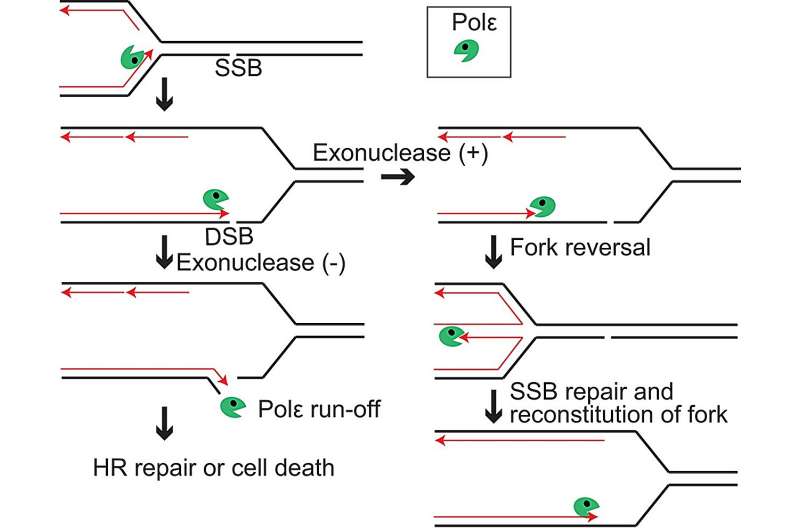This article has been reviewed according to Science X's editorial process and policies. Editors have highlighted the following attributes while ensuring the content's credibility:
fact-checked
peer-reviewed publication
trusted source
proofread
Key clues to DNA repair mechanism might lead to new cancer treatments

Researchers from Tokyo Metropolitan University have identified key factors in the mechanism behind DNA repair in our bodies. For the first time, they showed that the "proofreading" portion of the DNA replicating enzyme polymerase epsilon ensured safe termination of replication at damaged portions of the DNA strand, ultimately saving DNA from severe damage. This new knowledge arms scientists with ways to make anti-cancer drugs more effective and may provide new diagnostic methods.
Our DNA is under attack. Every day, around 55,000 single-strand breaks (SSBs) appear in the strands making up DNA helices in individual cells. When polymerases, molecules that replicate DNA strands, try to make new helices from strands with breaks in them, they can break the helix, creating what's known as a single-ended double-stranded break (seDSB).
Thankfully, cells have their own ways of dealing with strand damage. One is homology directed repair (HDR), where double stranded breaks are fixed. Another is "fork reversal," where the replication process is reversed, preventing the single-strand nicks turning into DSBs in the first place.
The exact mechanism behind fork reversal remains unknown. Understanding how DNA damage is prevented is paramount not only to prevent cancers, but also ensure the effectiveness of cancer drugs which rely on DNA damage. Take camptothecin (CPT), an anti-cancer drug that introduces lots of single-strand breaks; since cancer cells tend to replicate quicker, they create lots of seDSBs and die out, leaving normal cells less harmed.
Now, an international team led by Professor Kouji Hirata of Tokyo Metropolitan University have shed new light on how fork reversal works. They focused on polymerase epsilon, an enzyme responsible for making new DNA from a portion of the DNA which has unzipped. They discovered that the exonuclease, the "proofreading" portion of the polymerase that ensures copy accuracy, played a key role, a new, rare insight into the largely unknown molecular mechanism behind fork reversal.
The paper is published in the journal Nucleic Acids Research.
First, the team found that cells that are deficient in the exonuclease part showed strong susceptibility to exposure to CPT. Suppression of a factor known as PARP, the only other player known to affect fork reversal, also led to increased cell death. However, when both were suppressed, there was no further increase in cell death beyond what was seen with PARP. This suggests that PARP and the polymerase epsilon exonuclease work together to trigger fork reversal.
In addition, the team studied cells with the gene coding for BRCA1 (the breast cancer susceptibility protein) disrupted; additional deficiency of the exonuclease caused drastically increased sensitivity to CPT, far more than expected from either defect. Since BRCA1 deficiency is linked to a high risk of breast cancer, the exonuclease might be targeted to make drug treatments more effective.
The researchers have shown that drugs targeting the polymerase epsilon exonuclease can amplify the effect of anti-cancer drugs. Equally importantly, defects to the exonuclease have also already been seen in a wide range of cancers, including intestinal cancer; this makes it likely that such cells have impaired fork reversal capability, a promising target for future diagnostics as well as treatments.
More information: Tasnim Ahmad et al, The proofreading exonuclease of leading-strand DNA polymerase epsilon prevents replication fork collapse at broken template strands, Nucleic Acids Research (2023). DOI: 10.1093/nar/gkad999
Journal information: Nucleic Acids Research
Provided by Tokyo Metropolitan University





















